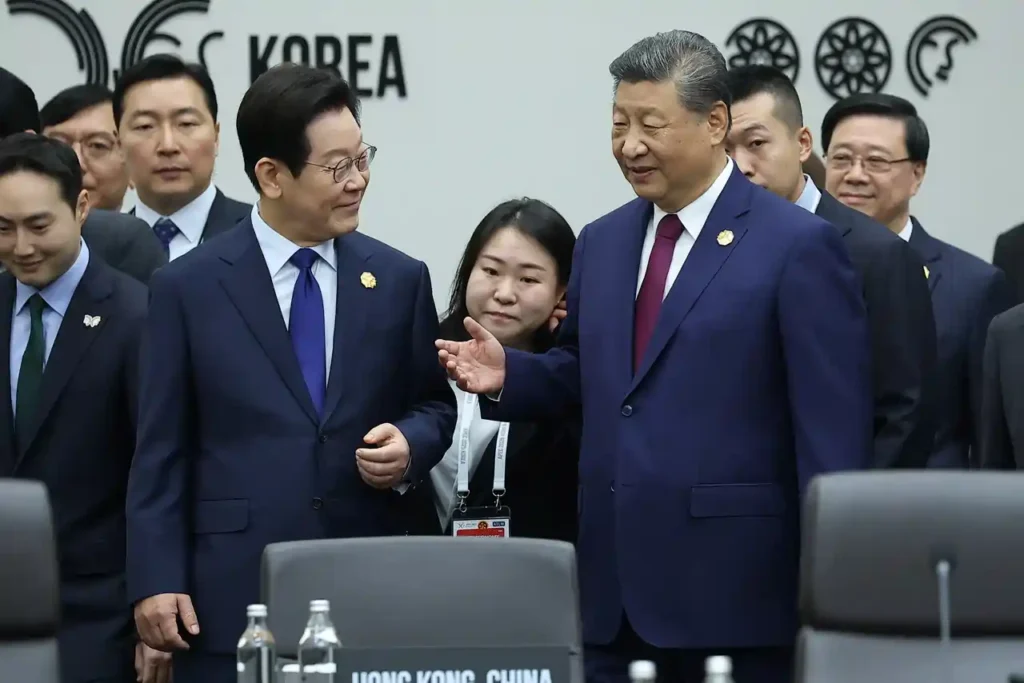New Delhi: The 2025 Asia-Pacific Economic Cooperation (APEC) Leaders’ Meeting concluded Saturday in the ancient capital of Gyeongju after 48 hours of intensive dialogue, producing a comprehensive declaration, two flagship policy frameworks, and a fragile but notable détente in the U.S.-China trade relations. Beneath the surface of consensus-driven outcomes, however, a sharp exchange between Taiwan and China over next year’s summit in Shenzhen exposed the fragility of cross-strait engagement within one of the region’s few inclusive economic forums.

Taiwan-China Dispute Escalates Over Shenzhen Summit Conditions
Taiwan Foreign Minister Lin Chia-lung addressed parliament in Taipei on Wednesday morning, revealing that Beijing had formally assured “equal participation” and “safety guarantees” for Taiwanese delegates during the 2024 APEC summit in Lima, Peru. The pledge, Lin said, was documented in writing as China campaigned to secure hosting rights for the 2026 meeting.
“China made a clear, written commitment at the Peru summit to uphold Taiwan’s equal participation and ensure the personal safety of all attendees,” Lin told reporters. “Now, just one year later, Beijing has attached a long list of new conditions to our involvement in the Shenzhen summit—conditions that directly contradict that earlier promise.”
Lin pledged a robust defense of Taiwan’s rights, stating that Taipei would “mobilize like-minded partners across the APEC community” to push back against what he termed a unilateral breach of trust.
Taiwan operates within APEC under the politically neutral designation “Chinese Taipei” and has long adhered to an unwritten protocol of not sending its sitting president to leader-level summits. The arrangement has allowed the island to maintain a voice in regional economic governance despite the absence of formal diplomatic relations with any APEC member.
Responding from Beijing later the same day, Zhang Han, spokesperson for China’s Taiwan Affairs Office, insisted that Taiwan’s participation remains governed by the “one China principle” and the specific clauses embedded in APEC’s founding memorandums of understanding. “All arrangements must align with established practices and the political realities of the Taiwan Strait,” Zhang said, reiterating Beijing’s view that Taiwan is an inalienable part of the People’s Republic of China.
Taiwan’s democratically elected government categorically rejects Beijing’s claim to speak on its behalf in international settings. The current administration under President Lai Ching-te—whom China has branded a “separatist” and refuses to engage—has adopted a firmer stance on sovereign dignity, further complicating informal channels that once facilitated APEC coordination.
Historical precedents underscore the volatility of Taiwan’s APEC involvement when China hosts:
- 2001 Shanghai Summit: Taiwan boycotted the event entirely after Beijing rejected its proposed delegation head.
- 2014 Beijing Summit: Smooth participation occurred under the more conciliatory administration of President Ma Ying-jeou, who had signed over 20 cross-strait agreements, including the landmark Economic Cooperation Framework Agreement (ECFA).
With military pressure from China intensifying—daily air and naval incursions now routine—the 2026 Shenzhen summit risks becoming a flashpoint unless a face-saving formula emerges.
Gyeongju Declaration: Three Pillars for a Transformative Decade
The summit’s capstone document, the Gyeongju Declaration (2025), articulates a forward-leaning vision anchored in three interlocking priorities:
- Constructing the world’s most dynamic and interconnected regional economy
- Emphasis on resilient supply chains, seamless digital infrastructure, and harmonized regulatory standards.
- Equipping the region for the digital and AI transformation
- Recognition of AI as a dual-use accelerator for productivity and a disruptor of labor markets.
- Addressing shared challenges to ensure inclusive and sustainable growth
- Explicit linkage between economic prosperity and social cohesion, particularly for vulnerable populations.
The declaration reaffirms the Putrajaya Vision 2040, adopted in 2020 during Malaysia’s host year, which remains APEC’s long-range blueprint for an “open, dynamic, resilient, and peaceful Asia-Pacific community.”
APEC Artificial Intelligence Initiative (2026–2030): A Five-Year Action Agenda
The summit launched the APEC AI Initiative, a structured five-year program with four operational pillars:
| Pillar | Key Objectives |
| Innovation & Collaboration | Joint R&D centers, cross-economy AI sandboxes, and public-private technology transfer |
| Capacity Building | National AI skill academies, women-in-AI scholarships, SME digital adoption grants |
| Sustainable Deployment | Energy-efficient data centers, carbon-footprint benchmarks for AI models |
| Ethical Governance | Regional principles on bias mitigation, transparency, and human oversight |
Chinese President Xi Jinping used his plenary address to propose a World Artificial Intelligence Cooperation Organization (WAICO), envisioning a UN-style body to “ensure AI serves all humanity, not just a privileged few.” The idea drew polite acknowledgment but no commitments, particularly from the United States, which exited multilateral tech forums under the Trump administration.
A companion APEC Statement on Artificial Intelligence described the technology as “a catalyst for economic renewal” while warning of “profound risks to employment, privacy, and social stability.” Leaders called for “coordinated, non-binding policy toolkits” to be developed by the 2026 Shenzhen summit.
APEC Framework on Demographic Resilience
A second major deliverable, the APEC Framework for Demographic Changes, confronts three interconnected megatrends:
- Ageing populations: By 2050, one in four Asia-Pacific citizens will be over 65.
- Declining fertility: Total fertility rates in South Korea (0.78), Japan (1.26), and Singapore (1.05) are among the world’s lowest.
- Urban hyper-concentration: Over 55% of the region’s population now lives in cities, straining infrastructure and social safety nets.
The framework prescribes a multi-pronged response:
- Intergenerational policy design – Tax incentives for multi-generational households, lifelong learning credits.
- Labor-market adaptability – Upskilling pathways for mid-career workers displaced by automation.
- Fiscal resilience – Sovereign pension reform models, public-private long-term care insurance.
- Silver economy activation – Market incentives for senior-friendly tech, tourism, and financial products.
South Korea, facing the world’s most acute ageing crisis, positioned the framework as a signature legacy of its host year.
U.S.-China Trade De-escalation: A Fragile Reset
In a dramatic sideline development, U.S. President Donald Trump and President Xi Jinping announced an agreement-in-principle to:
- Resume bilateral trade negotiations suspended since 2023
- Phase down tariffs on $150 billion in reciprocal goods over the next 12 months
- Establish a joint working group on critical mineral supply chains
The deal was sealed in a 40-minute pull-aside meeting Friday evening, with Trump departing Gyeongju immediately afterward. White House readout emphasized “fairness and reciprocity,” while China’s foreign ministry highlighted “mutual respect for core interests.”
Xi used the vacuum to project leadership on global trade. In a written message to the APEC CEO Summit, he declared: “Investing in China is investing in the future. We will open wider, not narrower.” The remark drew sustained applause from the 800 business delegates in attendance.
South Korea–China Bilateral Harvest
Seoul and Beijing capitalized on the summit to deepen ties:
- Currency-swap renewal: Extended the KRW-CNY 60 trillion ($45 billion) facility for three years.
- FTA upgrade: Added chapters on digital trade, e-commerce authentication, and green supply chains.
- Cybersecurity MoU: Joint task force to combat cross-border online scams, particularly pig-butchering fraud rings.
Korean Peninsula: Seoul’s Diplomatic Push
President Lee Jae Myung, a center-left leader elected on a platform of pragmatic engagement with North Korea, used his bilateral with Xi to press for Beijing’s intervention. According to national security director Wi Sung-lac, Lee presented a three-phase roadmap:
- Humanitarian confidence-building (food/medical aid)
- Military de-escalation (hotline reactivation, no-fly zones)
- Structured denuclearization talks
Xi responded that China would “continue constructive efforts” but stopped short of specific commitments. North Korea’s Vice Foreign Minister Pak Myong Ho issued a blistering retort hours later, accusing Seoul of “dangerous delusions” about dismantling Pyongyang’s nuclear deterrent.
Lee told reporters Saturday: “Peace on the Korean Peninsula is not a regional luxury—it is the foundation of Asia-Pacific prosperity. We will take bolder, preemptive steps to lower tensions.”
Closing Joint Statement: Multilateralism Without “Free Trade”
The summit’s Leaders’ Statement acknowledged “significant challenges” to the rules-based trading system but avoided the phrase “free and open trade”—a deliberate omission to secure U.S. concurrence. Instead, it declared:
“Robust trade and investment remain vital to the growth and prosperity of the Asia-Pacific region. We reaffirm our commitment to the Putrajaya Vision 2040 and a trade environment that is open, fair, non-discriminatory, transparent, and predictable.”
Jeonghun Min, professor at South Korea’s National Diplomatic Academy, analyzed: “The wording walks a tightrope. It preserves APEC’s DNA of cooperation while accommodating Washington’s aversion to multilateral trade rhetoric.”
APEC Institutional Profile
| Metric | Detail |
| Founded | 1989 (Canberra, Australia) |
| Members | 21 economies |
| Population | 2.95 billion (≈40% of world) |
| GDP Share | 62% of global GDP (2021) |
| Trade Share | 48% of global trade (2021) |
| Decision Rule | Unanimous consensus, non-binding commitments |
| Secretariat | Singapore |
Member List (alphabetical): Australia, Brunei Darussalam, Canada, Chile, China, Indonesia, Japan, Republic of Korea, Malaysia, Mexico, New Zealand, Papua New Guinea, Peru, Philippines, Russia, Singapore, Chinese Taipei, Thailand, United States, Vietnam.
India’s APEC Engagement: Strategic Alignment, Structural Barriers
India has attended APEC meetings as an observer since the early 1990s but remains excluded from membership. Key obstacles:
- Moratorium on expansion (1997–present)
- Unanimity requirement – A single veto blocks entry
- Trade policy concerns – High agricultural tariffs, complex regulatory regime
- Geopolitical undercurrents – Quiet Chinese reservations
Yet New Delhi sees clear synergies:
- Indo-Pacific vision mirrors APEC’s open regionalism
- Digital India, Startup India, IndiaAI align with APEC’s tech agenda
- Act East Policy, IPOI, MAHASAGAR complement APEC connectivity goals
Indian officials at Gyeongju stressed that informal partnerships can still shape outcomes. “APEC’s agenda is no longer just trade—it’s technology, sustainability, and resilience. India is already a co-architect in these spaces,” a senior MEA source said.
Road to Shenzhen 2026
With China confirmed as the 2026 host, the Taiwan participation impasse will dominate preparatory talks. APEC’s consensus model means any member can block progress, though tradition favors pragmatic accommodation. Diplomats are exploring:
- A neutral “special envoy” formula
- Virtual participation options
- Safety assurances via third-party hosts
Failure to resolve the issue risks the first leader-level boycott since 2001, potentially fracturing the forum’s fragile unity.
Conclusion: Balancing Innovation and Geopolitics
The Gyeongju outcomes position APEC as a laboratory for technology-enabled growth and demographic adaptation—two existential challenges for the 21st-century Asia-Pacific. The AI Initiative and Demographic Framework are not mere declarations; they come with timelines, budgets, and working groups.
Yet the summit also laid bare the limits of economic insulation from political heat. The U.S.-China trade reset offers breathing room, but the Taiwan-China standoff reminds members that APEC’s strength—its inclusive table—can also be its vulnerability.
As President Xi prepares to welcome leaders to Shenzhen, the forum faces a defining test: can it uphold equal participation as a principle, or will 2026 mark the moment when geopolitics finally overrides economics?
FAQs
1. What is the APEC 2025 Gyeongju Declaration and what are its main goals?
The Gyeongju Declaration (2025) is the official outcome document of the APEC Leaders’ Meeting held in South Korea. It sets three core priorities: (1) building the world’s most dynamic and interconnected regional economy, (2) preparing Asia-Pacific economies for digital and AI transformation, and (3) addressing shared challenges to ensure inclusive growth. It reaffirms the Putrajaya Vision 2040 and introduces new frameworks on AI and demographic resilience.
2. Why is Taiwan accusing China of breaking a promise for the 2026 APEC summit?
Taiwan claims China gave a written commitment during the 2024 Peru summit to allow equal participation and safety guarantees for Taiwanese delegates when bidding to host APEC 2026 in Shenzhen. Taiwan’s Foreign Minister Lin Chia-lung says Beijing has now imposed “numerous conditions,” violating that pledge. China insists participation must follow the one-China principle and existing APEC rules.
3. What is the APEC Artificial Intelligence (AI) Initiative (2026–2030)?
It is a five-year regional program to promote inclusive, sustainable AI development. Key pillars include innovation collaboration, workforce capacity building, energy-efficient AI infrastructure, and ethical governance. China proposed a global World Artificial Intelligence Cooperation Organization, but the U.S. has shown no interest in joining.
4. What happened in the U.S.-China trade talks during the summit?
Presidents Donald Trump and Xi Jinping agreed to restart bilateral trade negotiations and reduce select tariffs on $150 billion in goods. A joint working group was formed to address critical mineral supply chains. The deal was announced on the summit sidelines, signaling a de-escalation in the U.S.-China trade war.
5. Why is India not a member of APEC, and what is its relationship with the forum?
India applied for membership in 1991 and 1997 but was blocked due to a moratorium on new members, consensus-based admission, concerns over its protectionist trade policies, and quiet opposition from China. India participates as an observer and aligns its Indo-Pacific strategy, Digital India, and Act East Policy with APEC’s goals on connectivity, AI, and regional integration.

